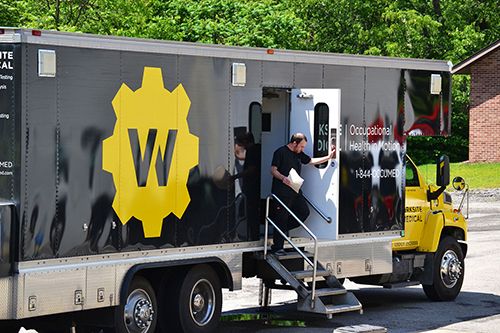Dangers of Cadmium
Occupational health and safety are paramount in any workplace, especially when dealing with hazardous substances like cadmium.
Cadmium is a toxic metal commonly found in industrial workplaces, particularly in industries such as mining, smelting, and battery manufacturing.
Unfortunately, while cadmium remains a crucial material to create batteries, solar energy, and bright pigments, exposure to cadmium can lead to serious health issues. Inhalation or ingestion of cadmium particles can lead to severe health problems, including lung damage, kidney disease, and even cancer.
To help regulate these dangers, employers are responsible for keeping their workers safe by remaining compliant with OSHA regulation 29 CFR 1910.1027.
This makes it crucial for employers to implement strict protocols to keep their worksites cadmium-proof. By following a comprehensive checklist and adhering to best practices, you can ensure the safety and well-being of your employees.
Let’s break it down.
Related Article: Reminder: Respirator Fit Testing is Required Every Year
Related Article: Heavy Metal Testing Should Not be Taken Lightly
Cadmium Exposure Compliance Checklist
1. Define Regulated Areas
Cadmium exposure is mostly likely to occur during the refining of metals, including electroplating, smelting, and metal machining. Employers are responsible for designating cadmium-regulated areas.
These areas are formed when there is an airborne concentration of cadmium that is five micrograms or more per cubic meter of air, also known as the Permissible Exposure Limit (PEL).
Once these areas have been identified, employees can work safely with the proper personal protective equipment (PPE).
2. Get Medical Clearance and Fit Tested for Respirator Use
Workers in regulated areas need the proper PPE.
Because cadmium most often becomes hazardous when inhaled, it’s necessary your employees wear air-purifying respirators. On cadmium exposed worksites, OSHA requires medical clearance and respirator fit testing.
Those requirements ensure that employees are safe from airborne exposure to cadmium and other dangerous substances, and that they’re medically able to wear respirators on job sites.
3. Take Measures to Reduce Exposure
OSHA estimates that over 500,000 workers in the United States are exposed to cadmium every year.
Besides wearing a respirator, there are several other ways you can reduce your team’s exposure.
If there is a concentration of cadmium on a worksite, isolate the source and use mechanical safety measures to ventilate the work area with fresh air to reduce exposure.
The easiest way to reduce cadmium exposure is to limit the amount of time a worker spends in a regulated area.
4. Perform OSHA-Required Medical Surveillance Testing
Under OSHA regulation 1910.1027(l), employers are required to perform occupational medical surveillance testing on employees who are exposed to cadmium.
With our skilled medical staff and mobile medical units, Worksite Medical can help your company fulfill this requirement by performing all of the OSHA-required Medical Surveillance Testing at your job site.
Required OSHA medical testing for Cadmium includes:
| ✔ Pre-Job Physical Exam | ✔ Work/Medical History Questionnaire |
| ✔ Annual Physical Exam | ✔ Medical Clearance for Respirator Use |
| ✔ Termination Physical Exam | ✔ Lab Testing: Heavy Metal Blood and Urine Testing |
| ✔ Chest X-Ray | ✔ Pulmonary Function Test – Spirometery |
| ✔ Respirator FIT Test | ✔ Written Medical Opinion of All Test Results |
| ✔ Additional Medical Tests if deemed necessary | ✔ Employee Counseling of Exam and Test Results |
OSHA Medical Testing for Cadmium: Comprehensive Guidelines for Worker Safety
OSHA regulations mandate stringent medical testing protocols for workers exposed to cadmium to safeguard their health and well-being. From pre-job physical exams to annual assessments and specialized tests, OSHA’s guidelines ensure thorough monitoring of cadmium exposure risks. Let’s delve into the key components of OSHA’s medical testing requirements for cadmium-exposed workers.
- Pre-Job Physical Exam
Before commencing work in environments with potential cadmium exposure, employees must undergo a pre-job physical exam. This assessment aims to establish a baseline health status and identify any pre-existing conditions that may be exacerbated by cadmium exposure.
- Work/Medical History Questionnaire
A comprehensive work and medical history questionnaire is essential to gather information about past exposures, existing health conditions, and potential risk factors that could impact an individual’s susceptibility to cadmium-related health issues.
- Annual Physical Exam
Regular annual physical exams are crucial for monitoring the health of workers exposed to cadmium. These exams help track any changes in health status, assess the effectiveness of control measures, and detect early signs of cadmium-related health problems.
- Medical Clearance for Respirator Use
Workers required to wear respirators for protection against cadmium exposure must receive medical clearance confirming their fitness to use respiratory protective equipment safely.
- Termination Physical Exam
Upon termination of employment in cadmium-exposed environments, workers should undergo a termination physical exam to assess their health status post-exposure and provide guidance on potential long-term health monitoring needs.
- Lab Testing: Heavy Metal Blood and Urine Testing
Regular blood and urine testing for heavy metal levels, including cadmium, is essential for monitoring exposure levels and assessing the effectiveness of control measures in place.
- Chest X-Ray
Chest X-rays are conducted to detect any lung abnormalities or damage caused by cadmium exposure, such as pneumonitis or fibrosis.
- Pulmonary Function Test – Spirometry
Spirometry tests measure lung function and help identify any respiratory impairments resulting from cadmium exposure, such as obstructive lung diseases.
- Respirator FIT Test
Respirator fit tests ensure that respirators provide an effective seal to protect workers from inhaling cadmium particles. Proper fit is crucial for the respirator’s efficacy in preventing exposure.
- Written Medical Opinion of All Test Results
A written medical opinion detailing all test results is provided to employees, outlining their health status, any identified concerns, and recommendations for further action or follow-up.
- Additional Medical Tests if Deemed Necessary
In cases where additional medical tests are deemed necessary based on initial assessments or test results, further specialized testing may be conducted to ensure comprehensive monitoring of worker health.
- Employee Counseling of Exam and Test Results
Employees receive counseling on their exam results, including explanations of findings, potential health risks associated with cadmium exposure, and guidance on preventive measures or follow-up care.
Key Takeaways
Protecting your employees from cadmium exposure requires a comprehensive approach that includes risk assessment, engineering controls, PPE provision, safe work practices, monitoring, training, emergency response procedures, and regular inspections.
By following this checklist diligently and continuously improving safety measures, employers can create a cadmium-proof worksite that prioritizes the health and well-being of their workforce.
So, now that you’ve got the checklist, are you ready to get started? Contact Worksite Medical today and see how easy it can be!
About Worksite Medical
In most cases, OSHA requires medical surveillance testing, and at no cost to employees.
Worksite Medical makes that program easier with mobile medical testing.
If you’re in need of DOT physical exams for your team, look no further! We offer both individual and company-wide DOT physical exams. For more information on what DOT physical exams involve, or to schedule exams for you and your team, head to: DOT Physical Exams
Additionally, we conduct on-site respirator fit tests, as well as audiometric exams, pulmonary function tests and heavy metal lab work, right on your job site. We also keep accurate, easy-to-access medical records for your convenience. You’ll keep your employees at work, and stay ahead of OSHA inspections.
With Worksite Medical, a mobile medical testing unit — we can bring all the resources of a lab to you. Our certified lab technicians can perform both qualitative and quantitative respirator tests to ensure a perfect fit.
Protect your team and your workplace now with Worksite Medical. Not sure what you need? Try our medical testing wizard here.
Give us a call at 1-844-622-8633, or complete the form below to schedule an on-site visit or to get your free quote.

Create a Less Disruptive, More Productive Occupational Health Plan with Worksite Medical!
Are you looking for a way to keep your team safe, while also limiting risk and increasing production? Simplify your medical plan today. We help team leaders like you develop less disruptive, more convenient occupational health plans that comply with complex industry standards, thus creating a healthier, more productive workforce. Take control of your medical testing program, and make sure your team is within NFPA 1582 requirements.




